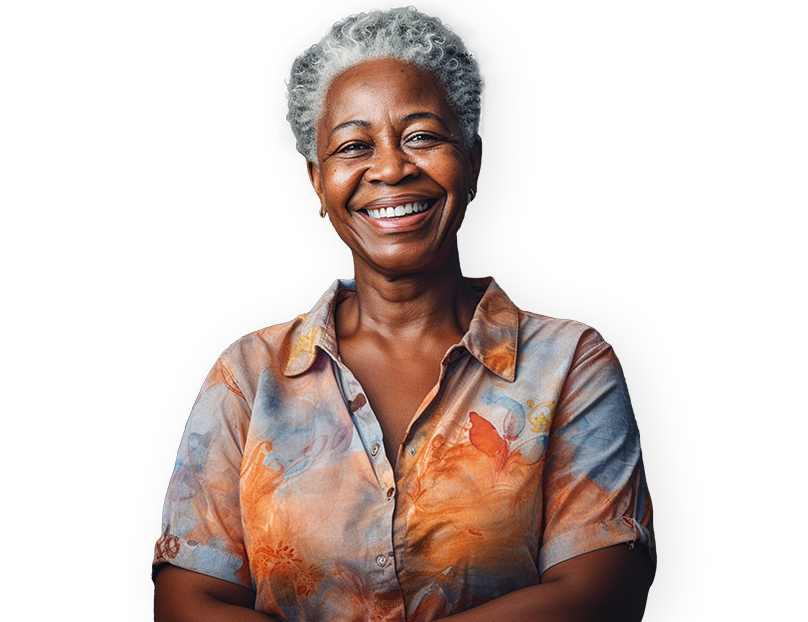Our team supports you
Discover how we can helpReceiving a breast cancer diagnosis can be frightening, but you’re not alone. The Larivière et Massicotte pharmacy team is here to support you through this difficult time, working with your healthcare specialists to ensure the best possible pharmacological treatment. Do not lose hope: breast cancer treatments are progressing at an incredible pace, and research has never been so promising. We’re here to give you peace of mind. You focus on fighting the disease, we’ll take care of the rest.
We’re here to help you.

What is breast cancer?
Diagnosis
If you notice a suspicious lump in your breast, it’s important to consult a doctor immediately. They can perform a physical examination or mammogram, which is a low-dose X-ray that detects the presence of breast abnormalities. To confirm if it’s a cyst or a solid mass, an ultrasound may be recommended.
Determining whether a cyst contains malignant cells is simply a matter of taking a liquid sample with a needle, whereas a solid mass requires microscopic analysis following a biopsy. Cancerous cells may require testing for the presence of estrogen or progesterone receptors, which will guide treatment.
Other tests are available, including magnetic resonance imaging, bone scans, or CT scans to check whether the cancer has spread to other organs or tissues.
Symptoms
A lump or mass in the breast is the most common symptom of breast cancer that can be detected during breast self-examination. It’s not usually painful, but may cause an unusual sensation where the lump is located. It is possible that the size or shape of the breast may change when a lump develops.
Swelling in the armpit, dimpling, a reddish rash, or breast swelling are other symptoms that may be early signs of breast cancer and require immediate consultation with a medical specialist, even without the presence of a lump. They may, however, be related to a condition that is not cancerous. While determining the exact cause of a lump is important, it should be noted that around 8 out of 10 lumps are non-cancerous.
Treatments
A number of factors can influence the choice of treatment for breast cancer, including how quickly the tumour progresses, its response to prior treatments, or whether there is dissemination, meaning whether cancer cells break away from the tumour and spread elsewhere in the body.
Early detection can reduce the risk of spread and increase the chances of recovery. Several treatments are available, such as surgery, chemotherapy, radiotherapy, and hormone therapy. Surgery involves complete or partial breast removal. With partial removal, known as lumpectomy or partial mastectomy, only the tumour and a few surrounding tissues are surgically removed, while with a simple mastectomy, the entire breast is removed. Chest tissue, muscles, and lymph nodes may also have to be excised. Knowing the precise location of the tumour is necessary for a successful surgical treatment and radiotherapy, unlike systemic cancer treatments.
Chemotherapy consists of injecting drugs to destroy cancer cells in various parts of the body. This treatment can have a number of side effects, since it harms not only cancer cells, but also healthy ones. Patients may experience nausea, vomiting, and hair loss. Hormonal treatment can also slow the growth of cancer cells. Menopausal women whose cancer has hormone receptors can also benefit from this treatment.
In some cases, a targeted treatment can be administered. This is the case for patients overexpressing the HER2 protein, for high-risk patients, or those with an advanced disease.
Our pharmacists are here to answer your questions, contact us.
How can Larivière & Massicotte support you ?
Our mission
Our committed team works hand in hand with community pharmacists, healthcare teams, and various healthcare professionals to support patients with cancer, ensuring the best possible care for them.
Common questions
What are the risk factors for breast cancer?
The causes of breast cancer are numerous and vary from one person to another. Some factors can increase risk, such as gender and age, with women aged 50 and over being the most affected. Other factors include age at pregnancy (over 30 years) or first menstrual cycle (under 12 years), family and genetic history, late menopause (over 55 years), taking oral contraceptives over several years, smoking, alcohol consumption, obesity caused by a high-fat diet and lack of physical activity, hormone therapy over several years, or chest radiotherapy before age 30.
The above-mentioned factors have a statistically low risk of increasing the risk of cancer. Age is the most common factor for women.
How can I prevent breast cancer?
Hormone therapy can help reduce the chances of breast cancer in high-risk women. As every medication involves some risks, a thorough examination is necessary before resorting to preventive treatment.
Other precautions can be taken, such as physical exercise, adopting a healthy diet that limits fats and favours fruit and vegetables, reducing alcohol consumption, and being aware of the risks associated with hormone therapy over several years.
It’s crucial that women know how to analyze the appearance and texture of their breasts, so they can notice any changes as soon as they occur. Average-risk women aged between 50 and 74 should have mammograms and breast examinations every 2 years, and women aged between 40 and 49 are advised to discuss these tests with their medical specialist. These precautions allow early detection of the disease, which can greatly influence the success of treatment.
What are the stages of breast cancer?
At initial diagnosis, cancer is categorized by stage, based on its location and the extent of its spread. Information about the stage, such as the size of the tumour, the parts of the organ affected, and how far it has spread throughout the body, helps the doctor plan treatments and determine the prognosis. Breast cancer falls into 5 stages, from 0 to 4. The higher the stage, the greater the size and spread of the cancer. The TNM staging system is the most widely used system for breast cancer, and is used to assess:
Tumour size and invasion of neighboring tissues (T)
Spread of cancer to lymph nodes (N)
Spread of cancer to other areas (metastasis) (M)
Hormone receptor status
HER2 status
Grade
Our pharmacists are here to answer your questions, contact us.
Resources to help you further
Consult our guides and resourcesQuebec Breast Cancer Foundation | Pink Ribbon
Provides support for people affected with breast cancer and their families through research, assistance, and awareness.
Canadian Breast Cancer Network
A Canada-wide network made up of 225 organizations and several hundred individuals, working with breast cancer survivors.
Hope & Cope
A non-profit organization providing psychosocial support services to cancer patients and their families.
Virage
The Virage support group helps cancer patients and their loved ones through diagnosis, treatment, and beyond.
Quebec Cancer Foundation
The Quebec Cancer Foundation provides information, support, and lodging for cancer patients and their loved ones, to help people live better with the disease.



